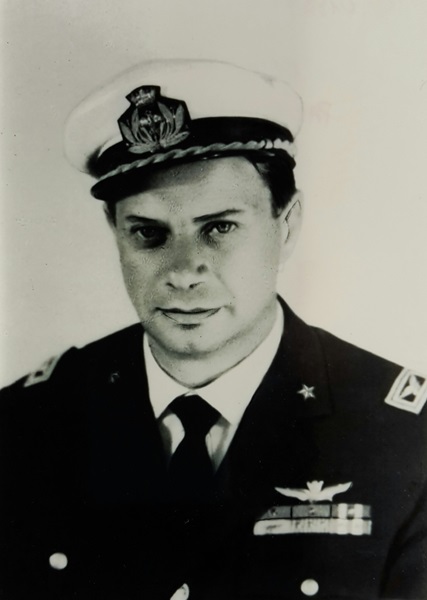Italy

Sottotenente Amedeo Parmeggiani Medaglia d’oro al valor militare
Italy

Sottotenente Amedeo Parmeggiani Medaglia d’oro al valor militare

8 April 1918 – 11 November 1961
| Date | Decoration | Note |
| ??/??/94 | Medaglia d’oro al valor militare (Posthumous) | |
| ??/??/43 | Medaglia di bronzo al valor militare (1st) | 1940-43 |
| ??/??/46 | Medaglia di bronzo al valor militare (2nd) | 1943-45 |
Amedeo Parmeggiani was born in Bologna on 8 April 1918,
After completing his studies he enlisted the Regia Aeronautica, obtaining his military fighter pilot license at the Castiglione del Lago school.
In October 1941, Amedeo Parmeggiani served in the 376a Squadriglia Autonomo C.T. This unit was at the time equipped with Fiat CR.42s.
During the night of 28 October, Parmeggiani and Marcello Calafiore claimed a shared Wellington over Naples.
The Wellington was from 104 Squadron.
Later in the war, he fought on the Eastern Front.
Sottotenente Parmeggiani was decorated with his first Medaglia di bronzo al valor militare (gazetted 1943) for his actions on the Eastern Front between April and June 1942:
“Fighter pilot, he carried out intense combat activity. In a fight and strafing of an advanced airfield, he contributed to the shooting down and destruction on the ground of various enemy aircraft, demonstrating himself to be a courageous and generous combatant.”
Skies of Russia, April-June 1942.
After the Italian surrender on 8 September 1943, he moved to the south and joined the Italian Co-Belligerent Air Force.
Due to war merits, he was promoted to Sottotenente in permanent active service of the Air Force, with seniority in the same rank on 1 April 1944 (gazetted 12 May 1944).
Sottotenente Parmeggiani was decorated with a second Medaglia di bronzo al valor militare (gazetted 1946) for his actions between 17 July 1943 and 31 December 1944:
“A skilled and valiant fighter pilot, he consistently demonstrated expertise and daring in all theaters of war, participating in numerous risky high-altitude and low-flying missions. During two fierce combats against overwhelming enemy forces, he effectively contributed to the probable downing of one aircraft and the effective strafing of six others.”
Skies over the Balkans and Southern Italy, 17 July 1943 – 31 December 1944.
He also received the authorization to wear the badge of the Liberation War with two stars.
Parmeggiani ended the war with 1 shared biplane victory.
After the war, he joined the newly formed Italian Air Force, entering service with the 46th Aerobrigata in Pisa.
He was killed, along with twelve other Italian soldiers, in the massacre of Kindu, Congo, which took place on the night between 11 and 12 November 1961, while carrying out a humanitarian mission aboard a twin-engine Fairchild C-119 Flying Boxcar operating under the aegis of the UN.
The bodies of the unfortunate airmen were found in February 1962, buried in two mass graves. The bodies were exhumed on 23 February 1962 and on 10 March 1962 transferred to the Libyan base of Wheelus. From here they arrived at Pisa airport on 11 March, and the following day the solemn funeral was celebrated, in the presence of the President of the Republic Antonio Segni. Later the bodies were buried in the Memorial of the Fallen of Kindu, specially built in the military airport of Pisa thanks to a public subscription.
For his sacrifice, Parmeggiani was awarded a posthumous Medaglia d'oro al valor militare (gazetted 1994):
“Leader of an air transport mission and crew chief of a transport aircraft, within the framework of Italian participation in the UN Forces' intervention in the former Congo, aware of the dangers he faced but confident in the symbols of the international organization and convinced of the necessity to prioritize the construction of the emerging nation over personal safety, he was overwhelmed by a horde of soldiers who had escaped the control of regular forces. Severely beaten under the threat of weapons, he intervened in defence of his men, asserting their Italian nationality and the neutrality of the parties. Taken hostage and subjected to continuous new violence, he was brutally murdered, offering his life for the pacification of peoples and arousing profound emotion worldwide. A shining example of utmost self-sacrifice and silent martyrdom.”
Kindu, 11 November 1961.
Claims:
| Kill no. | Date | Time | Number | Type | Result | Plane type | Serial no. | Locality | Unit |
| 1940 | |||||||||
| 28/10/41 | night | 1/2 | Wellington (a) | Shared destroyed | Fiat CR.42 | Naples | 376a Squadriglia |
Biplane victories: 1 shared destroyed.
TOTAL: 1 shared destroyed.
(a) Wellington from 104 Squadron.
Sources:
Elenco Nominativo dei Militari dell A. M. Decorati al V. M. Durante it Periodo 1929 - 1945 2 Volume M - Z
La caccia notturna italiana 1940-1943 - G. Grande, Storia Militare, April 2006
Wikipedia
Additional information kindly provided by Gianandrea Bussi.


